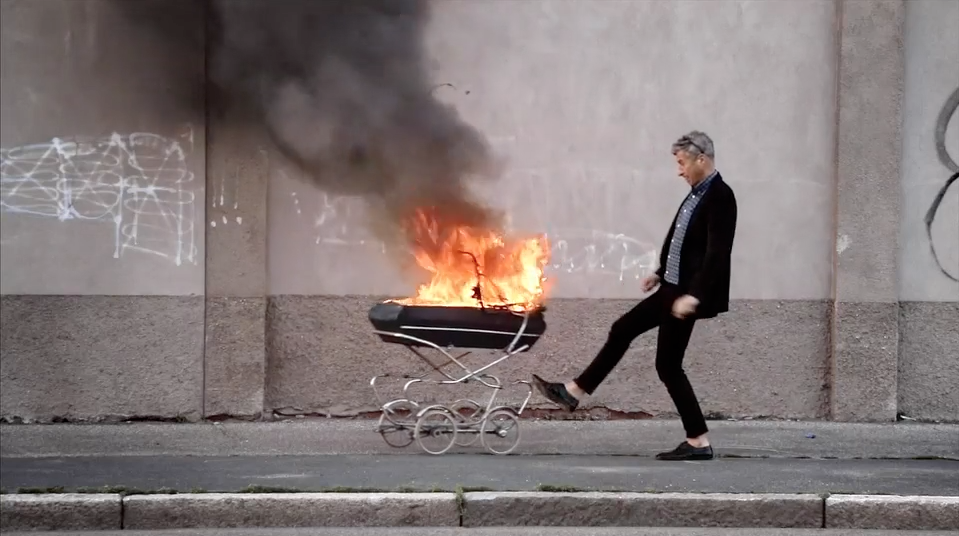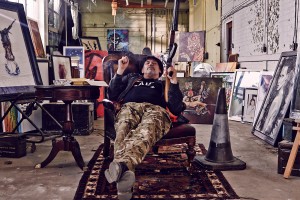
By Michael Miller.
The 15th Tribeca Film Festival unspooled April 13 – 24, 2016 in New York presenting nearly 200 features and shorts from around the globe. Here are six noteworthy titles that screened at the fest.
Several non-fiction and a feature films probed the nature and process of art and artists. The cheeky documentary Maurizio Cattelan – Be Right Back, directed by Maura Axelrod, profiles the renegade Italian conceptual artist from his origin as a poor boy from Padua though a retrospective of his career mounted by the New York Guggenheim in 2011. The film, which is as subversive as its subject, shows Cattelan challenging the very nature of what is art. In the piece that gives this film its name, Axelrod recalls an early solo gallery show Cattelan was committed to mount. However, the artist was creatively blocked. In a panic, he locked the door of the empty gallery as the show was scheduled to open leaving a note in Italian on the door that read, “Be Right Back.” That “stunt” became the show itself, and it was favorably received by most attendees. Axelrod also includes another, similar instance in which Maurizio faked a burglary at the gallery displaying the remnants of the break-in (jimmied locks and broken glass) in addition to the police report inventorying the stolen “work.” The film puts the artist’s playful spirit on display even if some of what is seen in the film is not to be taken at face value. That said, when the film unveils Cattelan’s monumental marble sculpture, “L.O.V.E.,” in the plaza outside the Bourse in Milan, the meaning of this hand with a single finger raised in an obscene gesture is pretty clear. Cattelan is a political prankster, not afraid to create a piece called “Ninth Hour” featuring Pope John Paul II being hit by a Meteorite. The lively film, which includes talking head interviews with various art folks discussing Maurizio and his work, is entertaining and succeeds in introducing the artist to a wider audience. But what really impresses is Cattelan’s piece de resistance, his Guggenheim exhibit in which all his work is literally hung from the ceiling of the famous museum. Watching the daring show being mounted is as breathtaking as Cattelan’s art.
Another film probing the nature of art, The Family Fang, directed by Jason Bateman, adds an overlay of family dysfunction to creative people. In this narrative feature, Nicole Kidman and Bateman portray Annie and Baxter Fang the adult children of Caleb (Christopher Walken) and Camille Fang (Maryann Plunkett), performance artists known for elaborate hoaxes. Annie and Baxter have reluctantly returned to the family home after their parents have gone missing under mysterious circumstances. As children, Annie and Baxter, Child A and Child B, were frequently unwilling participants in their parents’ performance pieces. Their existence as a family was primarily a work of art in the parents’ view, and every day was a performance; for the children this created a dissonance between what is real and what is not. That Annie and Baxter don’t trust their parents is a ‘side effect’ of their parents’ “art.” They attribute their unconventional upbringing to their current career struggles. Annie is an actress who wants to be taken seriously in her work and Baxter is a writer with a break-out first novel, a mediocre second and totally blocked working on the third. Brought together to search for their parents, they force each other to address long suppressed issues. But nothing can prepare them for what they find. Despite the neglectful upbringing the siblings endured at the hands of their narcissistic parents, they manage to heal each other. This film works at multiple levels and is a thoughtful contemplation on art and parenting.

In contrast, The Banksy Job, directed by Ian Roderick Gray and Dylan Harvey, playfully documents the one-sided rivalry between AK47, a self-anointed “art terrorist,” and the notorious but much beloved street artist, Banksy. With Andy Link (AK47’s real name), as our narrator, we follow his recreation and execution of the 2004 theft of Banksy’s public sculpture, The Drinker (a riff on Rodin). The heist itself purports to be a work of performance art, an assertion that quickly wears thin. In response to a ransom demand for the statue, Banksy offered only £2. That AK47’s back story includes stints as a porn star and an acid rave promoter hardly surprises as his larger than life personality overruns the screen. As the caper unfolds, our narrator’s veracity unravels, and a too-strong association with the Banksy-directed documentary, Exit Through the Gift Shop can’t be ignored. Finally, when AK47 recounts the original incident sparking his vendetta against Banksy, it prompts a shrug, not an Aha. This film begs the question: “Is it something; or is it nothing?” Sadly, it’s the latter.
Non-fiction filmmaking has a strong tradition at Tribeca and this year’s program is no exception. Here are some of the noteworthy titles.
Tapping the vein of social justice, Southwest of Salem: The Story of the San Antonio Four directed by Deborah Esquenazi, follows the ongoing story of four women accused and convicted in the 1994 sexual assault of two young girls they were babysitting. Occurring at the tail end of the Satanic ritual abuse panic, the women were targeted for prosecution in part because they were low-income Latina lesbians. This conventional documentary tells its story via archive news reports, talking heads, grainy home video and interviews with the subjects made over a number of years. This straight-forward presentation brings into stark relief the prejudice and homophobia present in the court proceedings. Twenty years later, the women are still trying to prove their innocence, and their case has been taken up by the Innocence Project of Texas along with a Canadian researcher enraged with the injustice of their case. Through a shrewd presentation of court documents and medical reports, Southwest of Salem effectively conveys the unconvincing nature of the state’s case against the San Antonio Four. Now released from incarceration, they are attempting to reverse their convictions and be exonerated of these crimes. Esquenazi’s film elicits indignation in the audience and presents yet again how the justice system can be perverted to punish those not in the mainstream of society.
Another affecting documentary was Contemporary Color, directed by brothers Bill and Turner Ross which presented a one-of-a-kind event staged by David Byrne at the Barclay’s Center in Brooklyn celebrating the art of Color Guard. Color guard, you may remember from your high school football halftime shows, is synchronized dance routines with flags, rifles, and sabers. The ten teams, which hail from the US and Canada, competed for invitations to the event have taken these performances to an extreme. Each routine is a satisfying riot of movement and color, sound and precision. The teams selected were each paired with a performer like Ira Glass, Saint Vincent, Nelly Furtado among others to create an original piece for the show. The teams are featured in individual sections of the film; via backstage interviews we get to meet the kids and their assigned performer. Color guard is hard work and the teens’ dedication is inspiring. Likewise, David Byrne is clearly having a good time as the camera follows him around backstage during the event. Anyone who’s a fan of Stop Making Sense, Jonathan Demme’s 1984 concert film of the Talking Heads tour, will recognize the energy, enthusiasm and Byrne’s showmanship as he guides these young teams in their dazzling performances. Byrne and the brothers Ross have done a great service with this film, bringing the magic of color guard to a wide audience.

Finally, Obit directed by Vanessa Gould, takes the viewer into the newsroom of The New York Times where we meet the women and men who research and write—on deadline—the obituaries published in the American paper of record. Far from dour or ghoulish, this documentary is a life-affirming celebration of the contributions of various and sundry individuals all of whom warrant an obituary in The Times. The film does a deep dive into to the minutia of the craft from the determination of whose life is noteworthy enough to make the cut, and if so, how many words their lives deserve. Hint: the lack of a printable photo can kill a piece. We also witness the writers’ phone interviews with the deceased’s family members as they gather the details on the subject’s life and how those facts can be verified (or not). Part of the craft we witness is the phrasing the writers use to document a life and hopefully prevent the need for a printed correction later on. This is a particular problem with obituaries where family histories can become embellished over time, or when the subject’s contribution to certain historic events are un-checkable; did Uncle George really command the PT boat in the south Pacific as the nephew no doubt was told as a child or was he merely a crew-member. Perhaps what the film does best is illustrate how these 400-800 word pieces fill in the details of 20th Century history one life at a time.
Michael Miller is an independent scholar who frequently reviews documentaries for Film International’s “Around the Circuit” column.
For more on the Tribeca Film Festival, see Gary Kramer’s festival report here.
